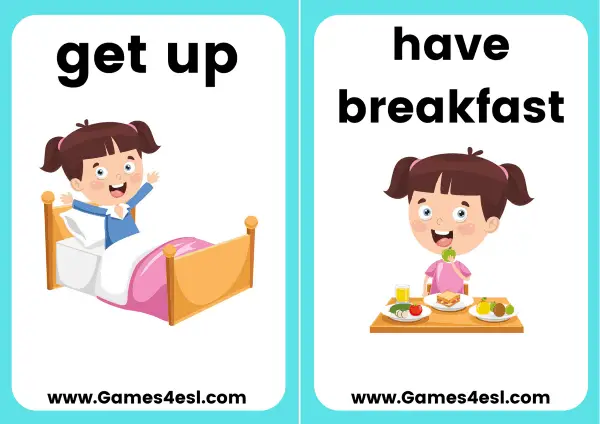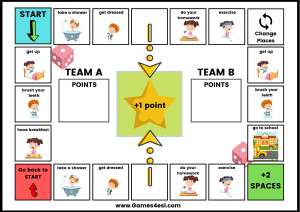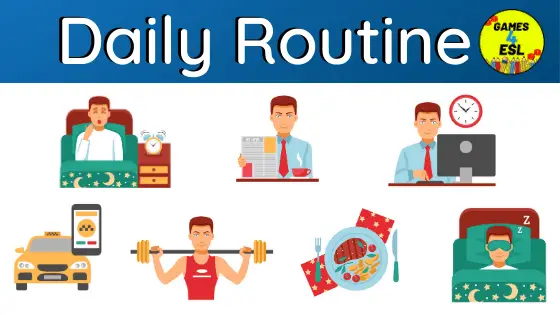Daily Routine | An ESL Lesson Plan Complete With Games And Activities
In this ESL lesson plan, students will use the present simple tense to talk about daily routines and activities. Students will practice describing their daily routine while playing fun classroom games. All the materials for the games and activities in this English lesson can be downloaded below.
Materials for this lesson:
Daily Routine | An ESL Lesson Plan
Grammar and Expressions used in this lesson plan:
This lesson plan will focus on daily routines using the present simple tense. We use the present simple tense to talk about things we do regularly. When talking about daily routine, we use the present simple form of the verb.
Examples:
- I (get up) at 8 o’clock.
- He/She (gets) up at 8 o’clock.
Introduction and Warm-up
Before introducing the keywords and expressions for the lesson, it is important to put the target language into context. A great way to do this when teaching daily routines is to ask the students about what they did before they came to school. Ask them what the first thing they did that day was.
Elicit from them that the first thing they did was ‘wake up’. Write this on the board, and ask students what they did next.
Once you have a few activities on the board, ask students which of those activities they do every day, and at what time they usually do them.
This should give students a clear idea that the lesson will be about activities they do regularly. That is, their daily routine.
Practice Key Words And Sentences

Using these daily activity flashcards, introduce the key phrases for the lesson. Ask students to repeat after you and practice many times. Once students have practiced the daily routine phrases, introduce the key expressions. For example,
- What time do you get up?
- I get up at 7 o’clock.
Once students have practiced enough, it’s time to play a fun guessing game and practice daily routine expressions.
Activity 1: Daily Routines Guessing Game
This video is one of Games4esl’s popular ‘Hidden Picture’ style games to practice making English sentences about daily activities.
To play, simply show the video in class. There are 10 pictures of daily activities hidden behind colored shapes. As the shapes slowly disappear, students must try to guess the daily routine in the picture. When students are ready to guess, they must answer using full sentences.
After each question, pause the video and ask students what time they do that activity. For example, after seeing the ‘get up’ picture, ask students what time they get up.
Activity 2: Daily Routines Board Game

This next activity is a printable board game about daily routines. Before class, print out this board game and prepare some dice. Give one dice and one board game to each pair of students. To start, students should place their eraser at the ‘Start’ square.
Next, one student should roll the dice and move their eraser. Then they should make a dialogue with their partner based on the picture in the square that they landed on.
For example, if they land on the ‘brush your teeth’ picture, they should ask their partner, “What time do you brush your teeth?” and their partner should answer.
Then, it is the other student’s turn to roll the dice. The aim of the game is to get to the star in the middle of the board game to win a point. The only way to get to the star is to land on squares in the middle (the ones with the arrows). After winning a point, that student then goes back to the start square.
Continue this game for 5 or 10 minutes, and the student with the most points at the end is the winner.
Activity 3: Daily Routine Speaking Game
In this speaking activity, students will talk about their daily routine while progressing through 4 different levels. To begin, explain to students that the four corners of the classroom are 4 different levels. Level 1, 2, 3, and 4.
Next, assign a daily activity to each of the levels. For example, level 1 = get up, level 2 = have breakfast, level 3 = go to school, and level 4 = go to bed.
All students will start at level 1 (get up) and find a partner. Then with this partner, they should ask and answer, “What time do you get up?”. Students should make their own answers.
After the dialogue, students should play rock, scissors, paper. The winning students then advance to level 2 (have breakfast), and the losing students should stay at level 1.
Next, students at level 2 should meet another student at level 2, and students at level 1 should meet another student at level 1. Again they should make a dialogue, then play rock, scissors, paper, and then advance to the next level if they win.
When a student has advanced through all 4 levels, that student gets a point (or sticker) and begins again at level 1. After 5 or 10 minutes, the student with the most points (stickers) is the winner.
Review Activity – Ball Toss
Before finishing the lesson, review the keywords and expressions that students learned. A great way to do this is to elicit a daily activity from the students. Then tell students to ask their partner what time they do that activity.
Next, toss a soft ball to one of the students. That student should tell the class what time their partner does that activity. Then that student can toss the ball to another student in the class to answer the question. Repeat with other daily activities to review what they have learned during the lesson.


